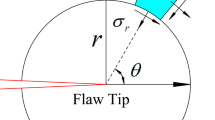Abstract
The effect of a transient thermal load on an interface crack in adhesively bonded dissimilar materials was experimentally studied by using photothermoelasticity. It is determined that the effect of the thermal load is to cause mostly shearing deformations at the crack tip. For two configurations, a horizontal crack (normal to the heat flow direction) and a vertical crack (parallel to the heat flow direction), it is shown that increasing the adhesive thickness results in steady-state and maximum transient strain-energy release rates and stress-intensity factors of smaller magnitudes. It is also found that the ratio of mode I to mode II stressintensity factors for the vertical crack is larger than the one for the horizontal crack.
Similar content being viewed by others
References
Williams, M.L., “The Stresses Around a Fault or Crack in Dissimilar Media,”Bull. Seismol. Soc. Amer.,49,199–204 (1959).
Erdogan, F., “Stress Distribution in Bonded Dissimilar Materials With Cracks,”J. Appl. Mech.,E32,403–410 (1965).
England, A.H., “A Crack Between Dissimilar Media,”J. Appl. Mech.,E32,400–402 (1965).
Rice, J.R. andSih, G.C., “Plane Problems of Cracks in Dissimilar Media,”J. Appl. Mech.,E 32,418–423 (1965).
Comninou, M., “The Interface Crack,”J. Appl. Mech.,E44,631–636 (1977).
Comninou, M., “The Interface Crack with Friction in the Contact Zone,”J. Appl. Mech.,E 44,780–781 (1977).
Comninou, M., “The Interface Crack in a Shear Field,”J. Appl. Mech.,E45,287–290 (1978).
Barber, J.R. andComninou, M., “The External Axisymmetric Interface Crack with Heat Flow,”Q.J. Mech. Appl. Math.,35,403–417 (1982).
Martin-Moran, C.J., Barber, J.R. andComninou, M., “The Penny-shaped Interface Crack With Heat Flow, Part 1: Perfect Contact,”J. Appl. Mech.,50,29–36 (1983).
Barber, J.R. andComninou, M., “The Penny-shaped Interface Crack with Heat Flow, Part 2: Imperfect Contact,”J. Appl. Mech.,50,770–776 (1983).
Kokini, K., “Interfacial Cracks in Ceramic-to-Metal Bonds Under Transient Thermal Loads,”J. Amer. Cer. Soc.,70,855–859 (1987).
Kokini, K., “Material Compatibility in Interfacial Transient Thermal Fracture of Ceramic-to-Metal Bonds,”ASME Trans., J. of Appl. Mech.,55,767–772 (1988).
Kokini, K., “Boundary Effects on the Interfacial Transient Thermal Fracture of Ceramic-to-Metal Bonds,” Advances in Ceramics (1988).
Anderson, G.P., Bennett, S.J. andDeVries, K.L., Analysis and Testing of Adhesive Bond, Academic Press, New York (1977).
Gurtman, G.A., andColao, A.A., “Photothermoelastic Investigation of Stresses Around a Hole in a Plate Subjected to Thermal Shock,”Experimental Mechanics,5,97–104 (1965).
Tsuji, M. andOda, M., “Investigation of Photothermoelasticity by Means of Heating,”J. Therm. Str.,2,215–232 (1979).
Miskioglu, I. andBurger, C.P., “Transient Thermal Stresses at Elliptical Holes Near an Edge,”J. Therm. Str.,7,19–33 (1984).
Emery, A.F., Williams, J.A. andAvery, J., “Thermal Stress Concentration Caused by Structural Discontinuities,”Experimental Mechanics,9,558–564 (1969).
Zhang, P. andBurger, C.P., “Transient Thermal Stress Intensity Factors of Short Edge Cracks with Equal Depth of Crack Tips”Eng. Fract. Mech.,24,589–599 (1986).
Kokini, K. andLong, M.A., “Transient, Thermal Fracture of Cracked Plates,”Experimental Mechanics,23 (4),373–381 (1989).
Kokini, K., “Experimental Investigation of the Effect of In-Crack and Out-of-Plane Cooling on the Thermal Fracture of Cracked Plates,”Proc. 20th Midwestern Mech. Conf.,14 (b),604–610 (Aug. 1987).
Kokini, K., Maragoni, R.D., Dorogy, G.M. andEzzat, H.A., “Crack Propagation Under Mode II Loading: An Effective Stress Intensity Factor Method,”Eng. Fract. Mech.,28 (1),93–100 (1987).
Gdoutos, E.E. andPapakaliatakis, G., “Photoelastic Study of a Bimaterial Plate with a Crack Along the Interface,”Eng. Fract. Mech.,6 (2),177–187 (1982).
Sanford, R.J. andDally, J.W., “A General Method for Determining Mixed-Mode Stress Intensity Factors from Isochromatic Fringe Patterns,”Eng. Fract. Mech.,11,621–633 (1979).
Sanford, R.J., “Application of the Least-squares Method to Photoelastic Analysis,”Experimental Mechanics,20,192–197 (1980).
Doyle, J.F., Kamle, S. andTakezaki, J., “Error Analysis of Photoelasticity in Fracture Mechanics,”Experimental Mechanics,21,429–435 (1981).
Author information
Authors and Affiliations
Rights and permissions
About this article
Cite this article
Kokini, K., Smith, C.C. Interfacial transient thermal fracture of adhesively bonded dissimilar materials. Experimental Mechanics 29, 312–317 (1989). https://doi.org/10.1007/BF02321414
Received:
Revised:
Issue Date:
DOI: https://doi.org/10.1007/BF02321414




